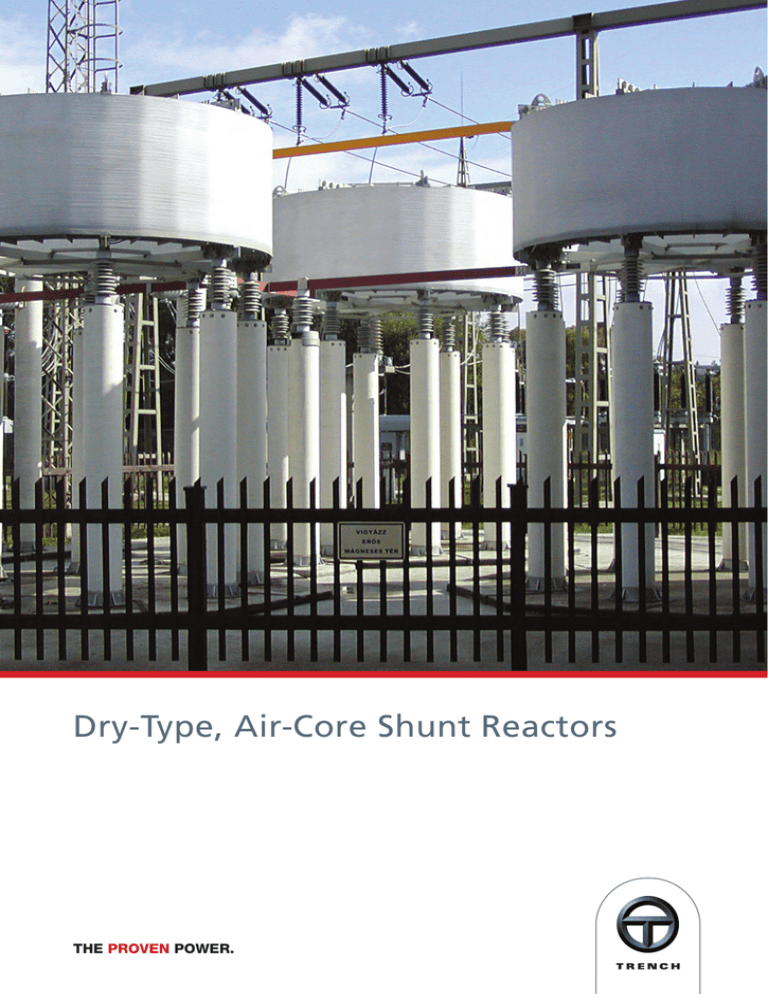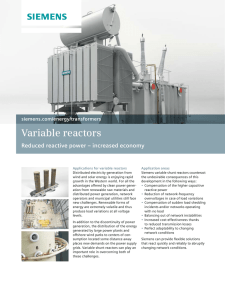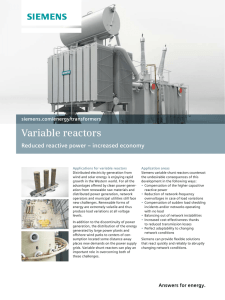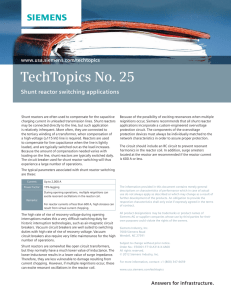Dry-Type, Air-Core Shunt Reactors
advertisement

Dry-Type, Air-Core Shunt Reactors THE PROVEN POWER. www.trench-group.com Introduction Shunt Reactors Trench is a supplier of specialized electrical products and a recognized world leader in the design and manufacture of dry type air core reactors for all utility and industrial applications. There are two general types of construction used for shunt reactors. These are referred to as “dry type” and “oil immersed”. The oil immersed construction typically consists of a winding and an iron core which are together housed in a steel tank that is filled with insulating oil. The dry type solution, on the other hand, consists only of the winding itself and support insulators. There is no iron core or steel tank. The insulation to ground is provided simply by the air space around the reactor winding and the support insulators. The basic dry type shunt reactor configuration is one of single-phase units arranged with adequate clearance between phases, connected in wye, with either a solidlygrounded or ungrounded neutral. If required, the neutral of shunt reactors connected to transmission lines may be grounded through a reactor. Trench air core reactors range from small kvar units for applications such as capacitor bank inrush limiting or distribution system short circuit current reduction, to large power reactors for a number of applications, such as shunt reactors that may be over 100 Mvar per coil. Main advantages of air-core, dry-type shunt reactors versus oil immersed types • n o environmental concern, no oil collection system required • no fire hazard, no fire deluge system • e ssentially no efforts and ongoing costs for maintenance • less civil work, lower weight • less efforts for transport and handling • simplicity of insulation to ground (self healing) • simple protection scheme • no risk of bushing failures • n o excessive magnetizing inrush current – no iron core • typically lower investment cost • less expenses for spare units (single phase unit only) • typically shorter lead time THE PROVEN POWER. www.trench-group.com The dimensions of the winding depend on several factors. As a matter of course, dimensions and weight will increase with the reactor’s power (Mvar) rating. To meet requirements for transportation and installation, the upper limits for outline dimensions of a single reactor unit are in the range of 4.5 meters (14.5 feet) in both, height and diameter. These dimensions translate into a maximum unit power rating per phase of approximately 100 Mvar at 50 Hz (based on a single coil per phase). Higher ratings are possible using multiple coils per phase. In addition to the basic Mvar rating, other factors such as low loss or voltage requirements may also govern the design and dimensions of the reactor. The winding length of air core shunt reactors is selected to meet the voltage stress imposed by the system voltage to which the reactors are connected. Shunt reactors which are approximately 4 m tall may be connected to system voltages up to 110 kV, when configured in wye. For higher voltages, two or more coils per phase may be put in series to keep the winding voltage stresses within acceptable limits. Dry type shunt reactors do not have an iron core or iron shield. Therefore, the magnetic field is not constrained and will occupy the space around the reactor. Although the magnetic field reduces in strength with increased distance from the reactor, the presence of this field, particularly for high power reactors, needs to be taken into consideration for possible effects on metallic components (grounding grids, beam structures, concrete rebar etc.) in the vicinity of the reactor. 2 Application of Shunt Reactors As the name implies, shunt reactors are connected in a parallel (shunt) configuration to the power system to compensate for the capacitive reactive power of transmission and distribution systems and thereby to keep the operating voltages within admissible levels. Two main applications of shunt reactors can be identified: a) reactors that are required permanently in service for stability reasons (especially on long transmission lines), or b) that are needed for voltage control in a meshed system and are switched in only during light load conditions, when there is an excess of capacitive reactive power. Depending on several factors shunt reactors may be connected (1) either to the tertiary winding of a power transformer, or (2) directly to the station busbar, or (3) to transmission line terminations (3), as shown in Fig. 1. (3) (3) Tertiary connected shunt reactors Depending on the customer’s requirements the reactive power rating of shunt reactors connected to the tertiary winding of a power transformer may vary from a few Mvar up to approximately 100 Mvar per phase. Because of their cost benefits, distribution class reactors in general and tertiary connected shunt reactors in particular, are usually of dry type design. Since the connection voltage at the tertiary is 34.5 kV or less, the voltage rating of the shunt reactor is usually not a controlling factor in the selection of the winding length. As a result the reactor may be designed with an optimum shape for minimum conductor length and thus for minimum cost. Such designs usually constitute the most cost effective solution for reactive power compensation. Fig. 2 shows a distribution class shunt reactor bank - 20 kV, 45 Mvar 3-phase, 50 Hz. (2) (1) Fig. 1: Shunt reactor application in power systems Fig. 2: 20 kV, 45 Mvar 3-phase tertiary shunt reactor THE PROVEN POWER. www.trench-group.com 3 Shunt reactors connected to the high voltage bus or to a high voltage line The majority of shunt reactors which are connected directly to the high voltage bus or transmission line are of oil-filled type. However, a number of shunt reactors of dry type design have already been applied at voltages up to 345 kV and the demand is growing. One factor driving this demand increase is the integration of renewable generation such as wind parks to the grid. The connecting overhead lines or cables require shunt compensation with ratings for reactive compensation in the range of some tens of Mvars. Usually such wind parks are located in environmentally sensitive areas thereby favoring dry type air core technology. Fig. 3 shows two 132 kV, 20 Mvar 3-phase, 60 Hz direct connected shunt reactor banks. Each phase consists of two stacked sub-coils, each being about 4 m tall. As shown in the figure, if required, the reactors can be elevated off the ground using support pedestals, so that live parts are not accessible to station personnel. For dry type shunt reactors applied at sub-transmission or transmission voltages the steady state voltage drop along the surface of the reactor is a decisive design parameter. As mentioned earlier, reactor windings which are approximately 4 m tall may be connected to system voltages up to 110 kV when connected in wye. For systems with voltage levels above, two single units, stacked one above the other and connected in series are required. Fig. 4 shows a shunt reactor bank for 345 kV, 20 Mvar 3-phase, 60 Hz, consisting of two series connected reactor stacks, mounted side by side, resulting in a total of four series connected coils per phase. Fig. 3: 132 kV, 20 Mvar 3-phase shunt reactor (2 banks) THE PROVEN POWER. www.trench-group.com For higher system voltages more than two coils must be connected in series. In principle, by connecting several coils in series, dry type shunt reactors may be applied at any system voltage. Fig. 4: 345 kV, 20 Mvar 3-phase shunt reactor 4 Wye connected shunt reactors with the neutral grounded through a neutral reactor The majority of faults on transmission lines are singlephase-to-ground faults caused by flashovers of the air insulation. Clearing of such faults is achieved by making use of the dielectric recovery of the air. For this purpose the affected phase of the line is temporarily isolated by opening the circuit breaker at both line ends and reclosing the breakers after a certain dead time. This operation is termed single-phase auto-reclosing (SPAR). Long EHV transmission lines are usually operated with shunt reactors permanently connected to the lines at their terminal stations, even when the lines are switched-off. Successful SPAR on such compensated lines is hampered by a phenomenon called secondary arcing. Instead of the extinction of the (primary) arc, the arc is further maintained due to capacitive and inductive coupling with the two healthy phases. A successful auto-reclosing is achieved only if this secondary arc extinguishes during the dead time when the breakers are open. For mitigation of secondary arcing it is a well proven practice to increase the zero sequence impedance of the shunt reactor by providing an additional single-phase reactor between the reactor’s neutral and ground. wye-connected shunt reactor with directly grounded neutral X0 / X1 ≤ 1 During normal operation, the neutral reactor is practically unloaded. In case of a SPAR operation, for less than one or two seconds the reactor is loaded by typically 15 to 25 % of the system voltage, depending on the parameters of the line to which the shunt reactor is connected. The short-time power rating of the neutral reactor is only a few percent of the shunt reactor’s continuous power rating. Due to the advantages of dry type over oil type reactors, practically all neutral reactors are dry type, for both oil immersed and dry type shunt reactors. Fig. 5: Air core dry type neutral grounding reactor Switching of shunt reactors wye-connected shunt reactor with neutral grounded through a reactor X0 / X1 > 1 Switching shunt reactors is one of the most severe duties for a circuit breaker. As a consequence, when applying shunt reactors, whether they be dry type or oil immersed, tertiary type or direct connected, it is extremely important to pay particular attention to the switching device which is selected and ensure it is capable of handling the task to which it is being applied. Guidance can be found in IEEE Std. C37.015-2009: IEEE Guide for the Application of Shunt Reactor Switching. X1: positive-sequence reactance of the shunt reactor X0: zero-sequence reactance of the shunt reactor (including the neutral reactor) THE PROVEN POWER. www.trench-group.com 5 Main data of Dry-Type, Air-Core Shunt Reactors Placement of Phase Reactors In line In triangle Table 1: Conceptual data of wye connected air-core, dry-type shunt reactors for 50 Hz systems U (kV) Mvar (3-phase) X-50 Hz (ohm) L (mH) I (A) D (mm) H1 (mm) H2 (mm) 20 50 60 20 50 100 20 50 100 20 50 100 20 40 60 5,0 2,0 1,7 20,0 8,0 4,0 54,5 21,8 10,9 238,0 95,3 47,7 605,0 302,5 201,7 15,9 6,4 5,3 63,7 25,5 12,8 173,3 69,4 34,7 757,8 303,1 151,6 1926,0 963,0 642,0 1155 2887 3465 578 1444 2887 350 875 1750 168 419 837 105 210 315 3100 3300 3400 3150 3350 3500 2900 3100 3200 2900 3000 3400 3100 3200 3250 1100 1300 1450 1350 1400 1900 2050 2100 2300 2950 3000 3100 3600 3650 3700 4200 4400 4550 4450 4500 5000 5150 5200 5500 6050 6100 6200 6700 6750 6800 10 20 33 69 110 H3 (mm) C (mm) M1 (kg) M2 (kg) Q 75°C 6800 6850 6950 7450 7500 7550 5200 5400 5500 5400 5500 5800 5200 5600 5700 5500 5700 6300 6200 6400 6500 1600 3200 3500 1700 2900 5000 2100 3200 5100 2700 5000 5600 2900 4200 6000 1900 3500 3800 2000 3200 5600 2400 3500 5700 3000 5600 6200 3200 4600 6600 125 210 235 110 185 295 110 180 275 95 165 220 85 140 170 U: rated system voltage (kV) Mvar: reactive power (Mvar) of a bank of three single phase reactors, at rated voltage X-50 Hz: reactance per phase (ohm) I:rated phase current (Amps); the reactors are designed to carry continuously 105 % of rated current without exceeding the temperature class limit Q:quality factor (X/R) of the shunt reactor, at 75°C; the numbers given in the table refer to “standard” reactor designs for minimum investment cost; reactors with higher Q-factors are feasible, if required. D, H1, H2, H3: reactor dimensions, see sketch C: minimum distance between phase reactors mounted side-by-side, based on a coupling coefficient between reactors of less than 1 % M1: mass per phase reactor, without support elements M2: mass per phase reactor, including support elements THE PROVEN POWER. www.trench-group.com 6 Appendix – Design Details of Trench Dry-Type, Air-Core Technology The sketch below illustrates the design concept of a Trench dry-type, air-core reactor. 1. winding 2. winding conductor 3. spider 4. terminal 5. duct stick 6. base insulator 7. mounting bracket A dry type air core reactor consists of a cylindrical winding (1) made of one or several concentric layers of film/glass tape insulated aluminum conductor (2). All layers are electrically connected in parallel by welding their top and bottom ends to metallic cross arms, commonly referred to as spiders (3). Each spider carries a terminal (4) for electrical connection of the reactor. The individual layers are configured such that radial voltage stress is virtually nil and the remaining axial voltage stress results in surface stress values that are less than those on porcelain insulators and turn-to-turn steady state operating voltages that are well below the level at which partial discharges can occur. All layers are radially spaced by several glass fiber sticks (5) which form air ducts necessary for the cooling of the winding. Cooling is provided by natural convection of ambient air, which enters at the bottom end of the winding and exits at its top end. THE PROVEN POWER. www.trench-group.com The winding is impregnated by epoxy resin resulting (after curing) in a mechanically strong and compact unit. The reactors are mounted on several base insulators (6) and according mounting brackets (7). 7 Trench Factories Trench Austria GmbH Paschinger Strasse 49 Postfach 13 A-4060 Linz-Leonding Austria Phone: +43-732-6793-0 Fax: +43-732-671341 Trench Brasil Ltda Via Expressa de Contagem, 2685 Contagem, Minas Gerais CEP 32370-485 Brazil Phone: +55-31-3391-5959 Fax: +55-31-3391-1828 Trench China MWB (Shanghai) Co., Ltd. No. 3658, Jiancheng Road Minhang, Shanghai P. R. China 200245 Phone: +86-21-54720088 Fax: +86-21-54723118 Trench High Voltage Products Ltd., Shenyang No. 2 Zhengliang Er. Road Jing Shen Xi San Street Dao Yi Economic Development Zone Shenyang 110136 P. R. China Phone: +86-24-89722688 Fax: +86-24-289737200 Trench Italia S.r.l. Strada Curagnata, 37 IT-17014 Bragno Cairo, Montenotte (SV) Italy Phone; +39-019-5161-111 Fax: +39-019-5161-401 Trench Limited Coil Products Division 71 Maybrook Drive Scarborough, Ontario Canada M1V 4B6 Phone: +1-416-298-8108 Fax: +1-416-298-2209 Trench France S.A. 16, Rue du Général Cassagnou B.P. 70 F-68 302 St. Louis, Cedex France Phone : +33-3-89-70-2323 Fax : +33-3-89-67-2663 Trench Limited Instrument Transformer Division 1865 Clements Road Pickering, Ontario Canada L1W 3R8 Phone: +1-416-751-8570 Fax: +1-416-751-6952 Trench Germany GmbH Nürnberger Strasse 199 D-96050 Bamberg Germany Phone: +49-951-1803-0 Fax: +49-951-1803-224 Trench Limited Power Line Carrier Division 330 Finchdene Square Scarborough, Ontario Canada M1X 1A5 Phone: +1-416-847-5400 Fax: +1-416-291-5581 The Trench Group is your partner of choice for electrical power transmission and distribution solutions today and for the development of your new technology solutions of tomorrow. THE PROVEN POWER. www.trench-group.com




